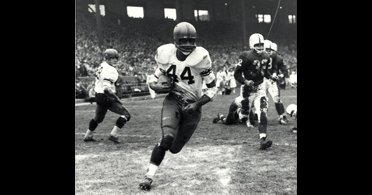Syracuse University Football Films Collection Now Available Online

A selection of football films from the University Archives in Syracuse University Libraries’ Special Collections Research Center (SCRC) is now available online at https://digitalcollections.syr.edu/syracuse-university-football-films-collection. The Libraries’ Digital Stewardship team, in collaboration with the SCRC, coordinated digitization of 430 films dating from 1949 to 1967 that included the major players wearing #44. This was part of a preservation effort to ensure that this important part of University history is sustained for long-term access. The digitization of the films was made possible through funding from Syracuse University Life Trustees Eric ’66, G’68 and Judith C. Mower ’66, G’73, G’80, Ph.D.’84, with additional financial support provided by Trustee Patricia H. ’64, G’66 and Louis A. Mautino ’61, G’62.
Of the 430 films digitized from the larger Syracuse University Audiovisual Collection, nearly 400 are now available through SU Digital Collections, the Libraries’ digital library portal. The content forms the core of the new Syracuse University Football Films Collection, a virtual collection created for the digital library where materials can be searched by date, keyword and more. The new digital master files will be added to and actively preserved on the Libraries’ digital preservation platform, ensuring that access to these films will persist well into the future.
“These films document one of the great eras of Syracuse University football. They include substantial footage of the #44 greats Jim Brown, Ernie Davis and Floyd Little, as well as other notable players such as Larry Csonka, John Mackey, Fred Mautino, Lou Mautino and Jim Nance,” said Meg Mason, University Archivist. “They also document the team’s 1959 undefeated national championship season and the work of Coach Ben Schwartzwalder. There is so much history in these films, and we’re really excited to preserve them through digitization and share them with the campus community and beyond.”
“Like many analog formats held in the Libraries, the 16mm films at the center of this project had become increasingly difficult to provide access to, both due to the obsolescence of playback equipment and the risks around physical deterioration of the media itself,” said Déirdre Joyce, head of Digital Stewardship and the Digital Library Program. “As such, digitization for the express purpose of content preservation has become our primary means of providing long-term access to audio-visual materials both now and into the future. This gift was both important and well-timed, helping us address some of the Libraries’ most at-risk content.”
“We’re grateful to Libraries’ donors like the Mowers and the Mautinos for their inspirational support in getting this important collection digitized,” said David Seaman, Dean of the Libraries and University Librarian. “These football films represent much more than a sport. They document an important part of the University’s history during an historical period in America’s history. Ensuring this is captured for future generations is an essential undertaking that will have value long into the future.”
